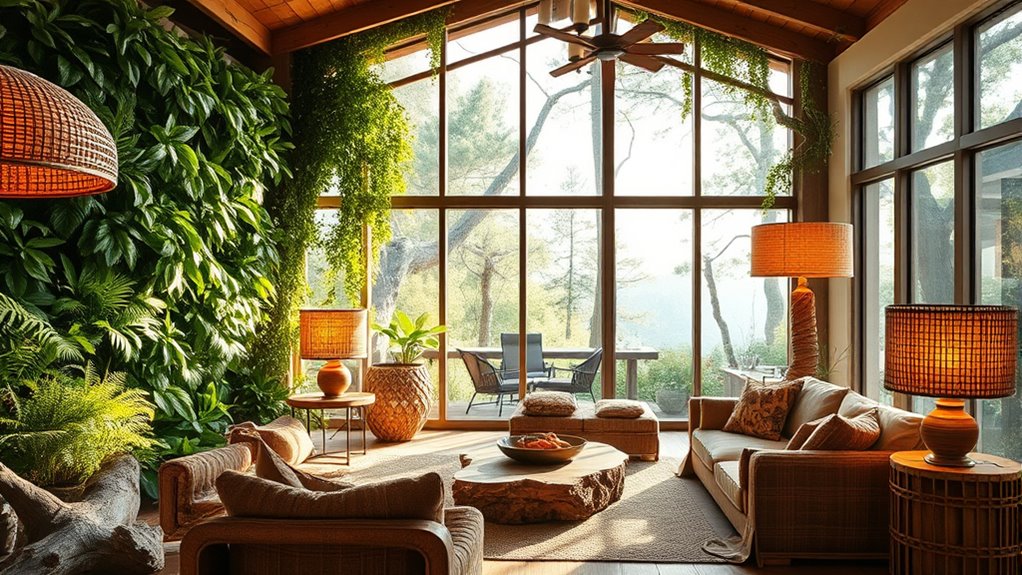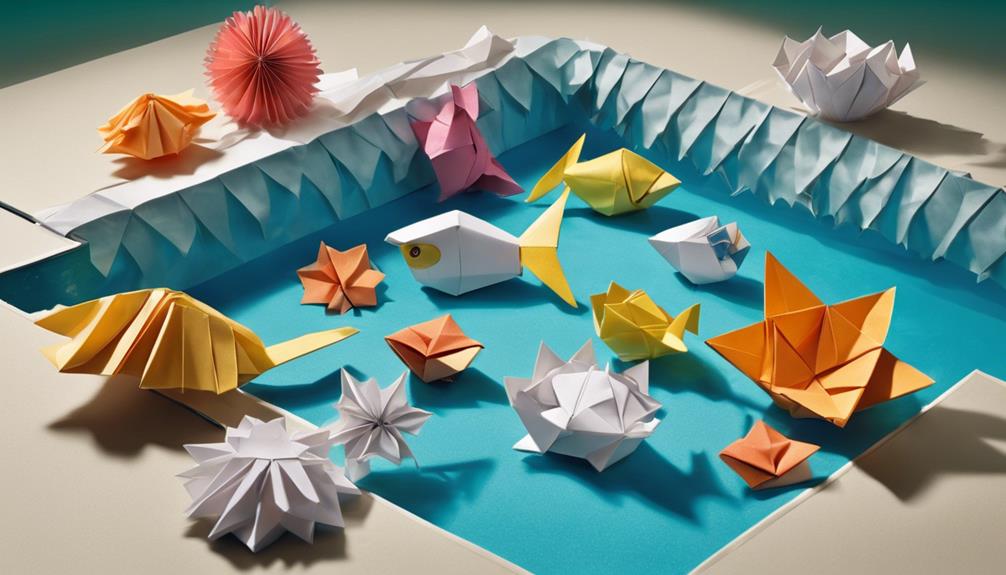In 2025, your interior spaces will reflect nature-inspired designs that emphasize sustainability, biophilic elements, and natural aesthetics. Expect to incorporate eco-friendly materials like reclaimed wood, bamboo, and recycled metals, creating warmth and character. Large windows and indoor plants will boost your well-being by connecting you with the outdoors and improving air quality. If you want to explore how these trends come together to transform your space into a tranquil, health-promoting environment, there’s much more to discover.
Key Takeaways
- Incorporate biophilic elements like indoor gardens and living walls to enhance well-being and outdoor connection.
- Use sustainable materials such as reclaimed wood, bamboo, and recycled metals for eco-friendly interiors.
- Maximize natural light with large windows and framing outdoor views to create tranquil, vitality-boosting spaces.
- Integrate indoor plants for air purification, aesthetic appeal, and a vibrant, natural ambiance.
- Focus on health and ecological stewardship through natural textures, durable sustainable materials, and harmonious design principles.

As we look ahead to 2025, interior design continues to evolve, blending technology, sustainability, and comfort into cohesive living spaces. One of the most prominent trends shaping this future is the integration of nature-inspired elements. You’ll find yourself increasingly drawn to spaces that incorporate biophilic elements—design features that connect you with the natural world. These include living walls, large windows that maximize natural light, and indoor gardens that bring greenery directly into your home. Incorporating biophilic elements isn’t just about aesthetics; it’s about creating environments that promote well-being, reduce stress, and boost your overall health. To achieve this, designers are turning to sustainable materials that echo nature’s resilience. These materials—bamboo, reclaimed wood, recycled metals, and bioplastics—are not only eco-friendly but also durable and stylish. When you choose sustainable materials, you’re making a conscious decision to lessen your carbon footprint while enjoying the warmth and authenticity that natural textures bring to your space.
In 2025, you’ll notice a shift toward using sustainable materials that are both environmentally responsible and visually appealing. Think reclaimed wood for flooring or furniture, which adds character and a story to your home, or recycled metal fixtures that lend a modern yet earthy vibe. These choices support the global effort to reduce waste and reliance on non-renewable resources. Furthermore, advancements in manufacturing tech mean these materials are becoming more affordable and accessible, making it easier for you to create a nature-inspired sanctuary without breaking the bank. The integration of biophilic elements and sustainable materials isn’t just a trend; it’s a lifestyle shift that emphasizes harmony with the environment. You’re encouraged to select finishes and furnishings that reflect the natural world, such as stone countertops or woven textiles made from organic fibers, which heighten your connection to nature while respecting ecological boundaries. Additionally, indoor air quality improvements are a key focus, with plants not only adding beauty but also helping to purify your living space.
As you plan your space, consider how these elements can work together to foster tranquility and vitality. Windows should frame views of the outdoors, while indoor plants can purify the air and add vibrancy. When you incorporate biophilic design principles and sustainable materials, you’re creating a home that’s not only beautiful and functional but also aligned with values of environmental stewardship. This approach transforms your living space into a retreat that nurtures your body and mind, emphasizing a harmonious coexistence with nature—exactly what 2025’s interior design landscape aims to achieve.
Frequently Asked Questions
How Sustainable Are the Materials Used in Nature-Inspired Interiors?
The materials in nature-inspired interiors are quite sustainable when you choose eco-friendly options and prioritize renewable resource sourcing. You can opt for bamboo, reclaimed wood, or recycled metals that reduce environmental impact. By being mindful of sourcing and selecting materials that are biodegradable or recycled, you guarantee your space remains eco-conscious. This way, your interior design supports sustainability and promotes a healthier planet.
Can These Designs Accommodate Modern Technology Seamlessly?
Yes, these designs can seamlessly accommodate modern technology. You can incorporate smart tech integration into nature-inspired interiors without disrupting minimalist aesthetics. For example, hidden wiring and sleek devices blend effortlessly with organic materials and earthy tones. This approach guarantees your space remains tranquil and functional, allowing you to enjoy innovative features while maintaining a harmonious, nature-inspired atmosphere.
What Are the Costs Associated With Implementing Such Designs?
The costs for implementing nature-inspired interior designs vary based on your choices, but a thorough cost analysis helps you stay within your budget considerations. Expect expenses for eco-friendly materials, custom furnishings, and subtle tech integration to add up. You should prioritize key elements and explore cost-effective options to balance aesthetics and functionality, ensuring your design remains sustainable without exceeding your financial limits.
How Do These Designs Cater to Urban Living Spaces?
You can easily incorporate biophilic elements and urban greenery into your space by adding indoor plants, green walls, and natural materials. These designs create a calming, invigorating environment that connects you with nature, even in a city. With smart use of space and sustainable options, you’ll enjoy a healthier, more inviting urban living space that boosts your well-being and aesthetic appeal.
Are There Specific Color Palettes Trending in 2025?
You’ll love the color palettes trending in 2025—they’re like a symphony of soothing shades that transform your space! Expect to see lush greens, earthy browns, and soft neutrals creating perfect color harmony. Natural textures like wood, stone, and woven fabrics complement these hues, making your home feel like a peaceful retreat. These palettes aren’t just trendy; they’re a timeless way to bring nature’s calm into your everyday life.
Conclusion
As you embrace nature-inspired interior design in 2025, you’ll find that it not only creates a calming, stylish space but also elevates your home’s sophistication. Some might think this trend limits creativity, but in reality, it offers endless possibilities to blend organic elements with modern elegance. By thoughtfully integrating natural textures and eco-friendly materials, you’ll craft a refined environment that’s both beautiful and sustainable—truly a timeless investment in your living space.









